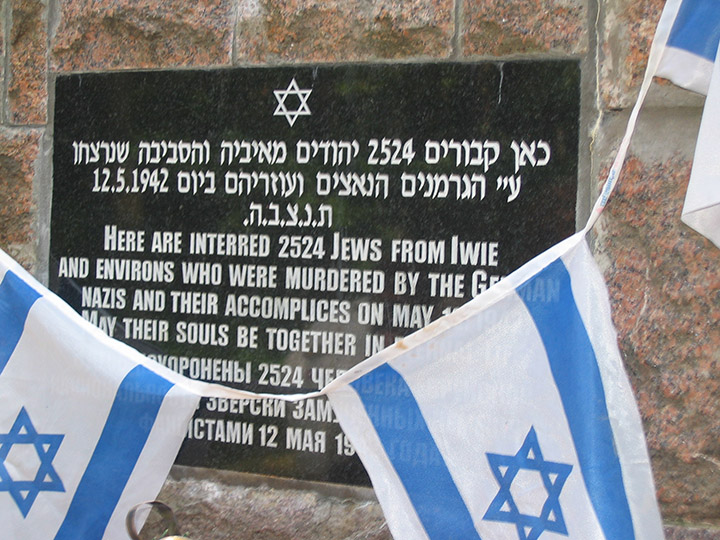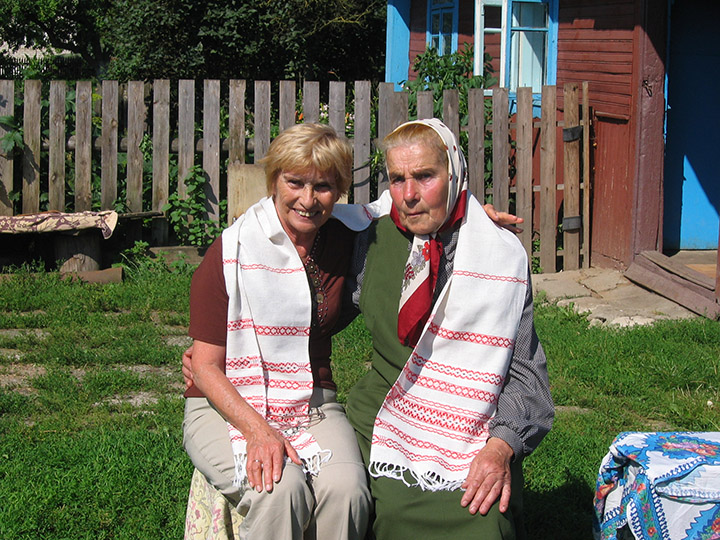|
Finding Esther Finding Esther

Survivor Jews of Iwje next to death pit Yad Vashem, Israel’s official Holocaust memorial, receives many requests to remember those who acted heroically during the Holocaust. Those non-Jews who saved Jewish lives may be then named Righteous Gentiles and remembered as such in ceremonies in the Holy Land and forever more in the site’s Garden of the Righteous. But those who are named Righteous Among the Nations must have their stories proven to be true; Yad Vashem fully researches and verifies each story and request it receives. This is the story of one of those…and it has a happy ending. An Annual Question Twenty-five years ago, Yad Vashem received a request from a group of Jews who had, before World War II, been part of the thriving Jewish community of Iwje, a town that was then part of Poland but today lies in Belarus. Iwje had been liquidated by the Nazis, with most of the town’s Jews being murdered. Those who survived had erected a memorial for their lost loved ones, and had taken to observing the anniversary of the Iwje Ghetto’s liquidation. Each year at the ceremony, an elderly Christian woman named Janina Pozniak would arrive and ask if anyone knew Esther, a Jewish girl who Janina’s family had sheltered during the Holocaust. Finding Esther Now, before the Nazis invaded Iwje, the town had been home to around 2,000 Jews. But after the murderous Germans were through, only a few Iwje Jews had survived. So despite those who still remembered, there were few who might have remembered this particular girl. One possibility was a woman named Esther who had moved to the United States. Yad Vashem contacted her, but because this Esther was so young during the Holocaust, she could remember nothing about her own survival. Without any proof as to who Esther was or what her story had been, Yad Vashem’s researchers closed this particular story without finding its ending. That was 1994. But then, in 2007, a new story reached Yad Vashem’s Jerusalem offices. This story came from a kibbutz in northern Israel, and was sent by a woman named Esther Ramiel. As the people at Yad Vashem read Esther’s story, they realized why this Esther had never been “found”: this Esther had not been from Iwje, but from the nearby town of Traby. And despite Esther having now been found, much of her story remained a mystery. Esther, Found
You see, no one from the Lewin family (Esther’s married name was Ramiel) had survived the Holocaust…no one except for Esther. And because Esther was such a young child when the Nazis murdered her family, she had no memory of what had transpired - she didn’t even know the year she had been born, only that it was probably 1939 or 1939. When the Nazis began killing the Jews of Esther’s hometown of Traby, the little girl’s mother smuggled her from the Traby Ghetto to the town of Iwje, which the Nazis had up to that point left alone. The family who Esther ended up in the care of was a large Christian family, the Pozniaks, who had nine children of their own. Despite this, Esther lived with Stanislaw and Tasilia Pozniak and their family until the war ended. Because Esther looked nothing like the rest of the family, neighbors became suspicious and several times informed the Nazis. But each search by the Germans turned up no hidden Jewish girl. You see, if strangers ever approached the house, young Janina Pozniak was in charge of hiding little Esther, either in the shed or in the nearby woods. And never was the little Jewish girl discovered, thanks to Janina’s quick thinking. Once the area had been liberated from the Germans, the few Jews from Iwje looked to rebuild their community. Because no one knew Esther’s story, she was included in the Iwje Jews’ group (including at the above service at a mass grave of those murdered by the Nazis…little Esther is in the white hat). With the Shmukler family, little Esther headed west, toward Germany. But once there, she was not taken to the United States with the rest. Instead, Esther was placed with a group of Jewish children who were sent to the Holy Land in 1946. An orphan alone in Israel, with no family and no story, Esther spent the rest of her childhood in boarding schools. She studied to be a teacher, got married, and the couple joined a kibbutz. Like so many Holocaust survivors, instead of dwelling on the dark days of her past, Esther looked ahead to a bright future for herself and her family. And while Esther did have vague memories of the family who had saved her life, she misremembered their name. Esther’s specialty as a teacher was teaching Hebrew to new olim (immigrants to Israel). Because of this, she was sent to Ukraine on a trip to help Jews there making aliyah (immigrating to Israel) prepare for their new home. Esther visited the town of her childhood, but all she found were mass graves. From Israel to Iwje It was only later that someone from Iwje’s Jewish community brought the above photo to one of the yearly memorial services. There, Janina Pozniak, now a very elderly woman some six decades later, identified the girl in the white hat as the very Esther her family had sheltered - and saved. The next year, Esther Ramiel and her family made the trip from Israel to Iwje. As the Israelis got off their bus, and despite it having been more than 60 years since Esther and the Pozniak family had seen each other, Janina immediately pointed Esther out. Despite not speaking the same language, the women’s bond was immediate. Between the two, they were able to fill in the gaps of Esther’s memory, the years she had lost along with her entire family. And with this information in her memory, Esther Ramiel was at last able to provide Yad Vashem with her story - a story that would find the Pozniak family at last named Righteous Gentiles on February 12, 2008.
|
|
|




